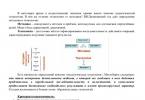Let the variable x n takes an infinite sequence of values
x 1 , x 2 , ..., x n , ..., (1)
and the law of change of variable is known x n, i.e. for every natural number n you can specify the appropriate value x n. Therefore, it is assumed that the variable x n is a function of n:
x n = f(n)
Let us define one of the most important concepts of mathematical analysis - the limit of a sequence, or, what is the same, the limit of a variable x n, running through the sequence x 1 , x 2 , ..., x n , ... . .
Definition. Constant number a called limit of the sequence x 1 , x 2 , ..., x n , ... . or the limit of a variable x n, if for an arbitrarily small positive number e there is such a natural number N(i.e. number N) that all values of the variable x n, beginning with x N, differ from a in absolute value less than by e. This definition is briefly written as follows:
| x n -a |< (2)
in front of everyone n N, or, what is the same,
Determination of the Cauchy limit. A number A is called the limit of a function f (x) at a point a if this function is defined in some neighborhood of the point a, with the possible exception of the point a itself, and for every ε > 0 there exists δ > 0 such that for all x satisfying condition |x – a|< δ, x ≠ a, выполняется неравенство |f (x) – A| < ε.
Determination of the Heine limit. A number A is called the limit of a function f (x) at a point a if this function is defined in some neighborhood of the point a, with the possible exception of the point a itself, and for any sequence such that ![]() converging to the number a, the corresponding sequence of function values converges to the number A.
converging to the number a, the corresponding sequence of function values converges to the number A.
If a function f (x) has a limit at point a, then this limit is unique.
The number A 1 is called the limit of the function f (x) on the left at point a if for every ε > 0 there exists δ > ![]()
The number A 2 is called the limit of the function f (x) on the right at point a if for each ε > 0 there exists δ > 0 such that the inequality holds for all ![]()
The limit on the left is denoted by the limit on the right - These limits characterize the behavior of the function to the left and right of point a. These are often called one-way limits. In the designation of one-sided limits for x → 0, the first zero is usually omitted: and . So, for the function 


If for every ε > 0 there exists a δ-neighborhood of a point such that for all x satisfying the condition |x – a|< δ, x ≠ a, выполняется неравенство |f (x)| >ε, then they say that the function f (x) has an infinite limit at point a:
Thus, the function has an infinite limit at the point x = 0. Limits equal to +∞ and –∞ are often distinguished. So,
If for every ε > 0 there is a δ > 0 such that for every x > δ the inequality |f (x) – A|< ε, то говорят, что предел функции f (x) при x, стремящемся к плюс бесконечности, равен A:
Existence theorem for an exact supremum
Definition:АR mR, m is the upper (lower) face of А, if аА аm (аm).
Definition: A set A is bounded from above (from below), if there exists an m such that aA, am (am) holds.
Definition: SupA=m, if 1) m is the supremum of A
2) m’: m’
InfA = n, if 1) n is the infimum of A
2) n’: n’>n => n’ is not the infimum of A
Definition: SupA=m is a number such that: 1) aA am
2) >0 a A, such that a a-
InfA = n is a number such that: 1) 1) aA an
2) >0 a A, such that a E a+
Theorem: Any non-empty set AR bounded from above has an exact supremum, and a unique one.
Proof:
Let's construct the number m on the number line and prove that this is the supremum of A.
[m]=max([a]:aA) [[m],[m]+1]A=>[m]+1 - upper bound of A
Segment [[m],[m]+1] - divided into 10 parts
m 1 =max:aA)]
m 2 =max,m 1:aA)]
m k =max,m 1 ...m K-1:aA)]
[[m],m 1 ...m K , [m],m 1 ...m K + 1 /10 K ]A=>[m],m 1 ...m K + 1/ 10 K - top edge A
Let us prove that m=[m],m 1 ...m K is the supremum and that it is unique:
k: )




